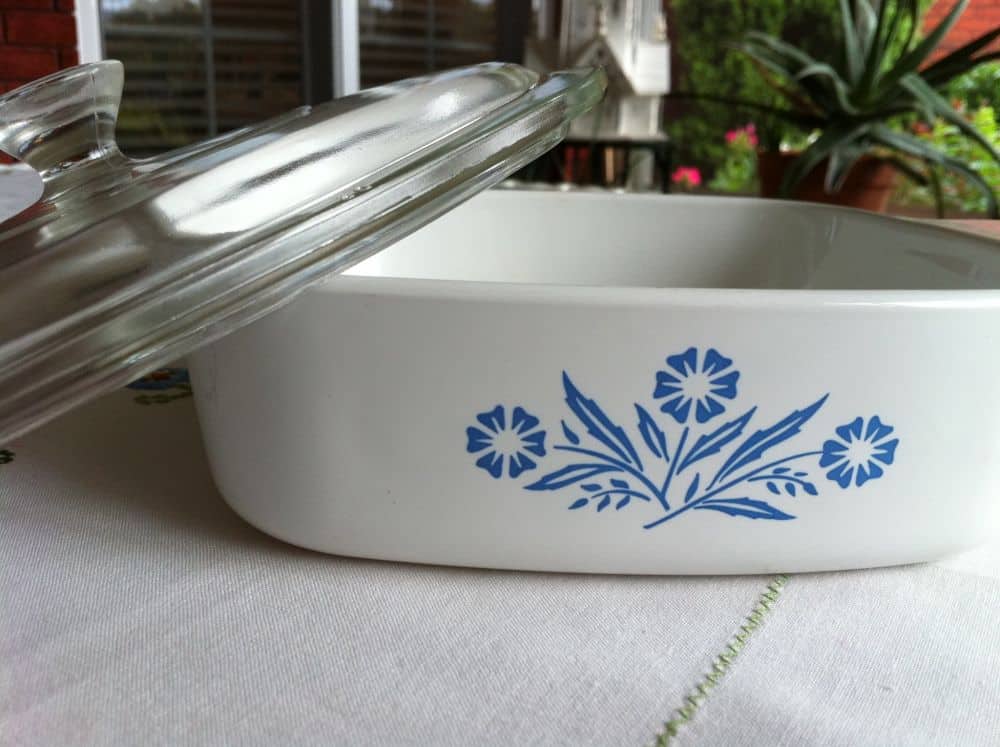
[Image above] Vintage CorningWare dish made from the glass-ceramic Pyroceram. There is still much to learn about creating glass-ceramics. Credit: Gerrilynn Nunley, Flickr (CC BY 2.0)
Big or small, every university has that one alumnus or alumna that is touted as a success story at every gathering. As an alumna of Coe College, I frequently heard praises for S. Donald Stookey.
Stookey was an American inventor with 60 patents in his name related to glass and ceramic materials. Arguably his most well-known discovery is that of glass-ceramics, which occurred thanks to a “lucky accident” in his lab at Corning in 1953. It resulted in the trademarked Pyroceram glass-ceramic, which was used to produce the acclaimed CorningWare cooking and baking products.
(Production of the Pyroceram-based CorningWare products ceased in 2000; the brand was relaunched as a line of stoneware-based bakeware in 2001. In December 2008, Pyroceram-based CorningWare was reintroduced as a line of stovetop products.)
While the tale of Stookey’s accidental discovery of glass-ceramics is well known, less discussed are the follow-up experiments he conducted to ensure the glass-ceramics could be reliably and consistently produced.
Nucleating agents were the core of Stookey’s glass-ceramics research. A nucleating agent is a material that, when added to a glass, leads to increased and (sometimes) more controllable formation of crystal phases in the glass. In Stookey’s case, he found titania was an effective nucleating agent for aluminosilicate glasses.
Much research has taken place on glass-ceramics in the 70 years since Stookey’s discovery. However, the nucleation process within glass-ceramics still is not understood across all glass systems, nor is the specific role of nucleating agents. A recent paper aims to help advance research in this area by clarifying some terms and effects for the glass-ceramics community.
The authors of the recent paper are led by two ACerS Fellows: John C. Mauro, Dorothy Pate Enright Professor at The Pennsylvania State University and recently announced editor-in-chief of the Journal of the American Ceramic Society, and Edgar D. Zanotto, senior professor at the Federal University of São Carlos and director of the Center for Research, Technology, and Education in Vitreous Materials (CeRTEV).
The authors begin by proposing a clear definition for nucleating agent: a minority component of the glass composition that leads to increased internal nucleation rates or precipitation and control of desired crystal phases, either by lowering the thermodynamic or the kinetic barrier for nucleation, or some combination thereof.
After breaking down in detail each part of the definition, they provide a table that summarizes the known nucleation mechanisms, nonmetallic nucleating agents, and functionalities based on more well-studied to thoroughly examined systems.
Regarding the nucleating agents, the authors note that to the best of their knowledge, no single component is reported to behave as an effective nucleating agent for all systems, except “water” (OH−). However, “a small group of compounds is commonly used in various systems,” including the oxides TiO2, ZrO2, P2O5, Ta2O5, MoO3, WO3, Fe2O3, Nb2O5, and Cr2O3.
Following this section, the authors discuss the complementary roles of thermodynamics and kinetics in the nucleation process. As their proposed definition for nucleating agent emphasizes, nucleating agents support crystal growth by lowering the thermodynamic and/or kinetic barrier for nucleation. However, characterizing and parameterizing the thermodynamics and kinetics of a system and separating their influence on nucleation is a major challenge for researchers.
The authors suggest one strategy for inferring whether a nucleating agent influences kinetics, thermodynamics, or both is to analyze their simultaneous effect on crystal nucleation and growth rates. Thermal analysis of the parent glass performed via differential scanning calorimetry can help clarify these influences.
At this point of the paper, with a framework established for defining nucleating agents and their effect on nucleation, the authors select a few common nucleating agents (TiO2, ZrO2, MoO3, P2O5, and OH−) to demonstrate the strength of their framework.
“However, there is still much to be learned, especially because of the breadth of possible combinations of nucleating agents to glass-ceramic system relationships,” the authors write. In the future, “It would behoove the glass community to have a better understanding of the structural effects on the thermodynamics and kinetics involved in these processes.”
The paper, published in Journal of Non-Crystalline Solids, is “Examining the role of nucleating agents within glass-ceramic systems” (DOI: 10.1016/j.jnoncrysol.2022.121714).
